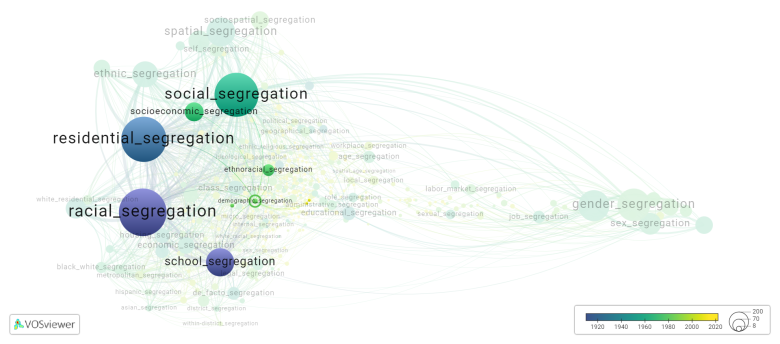Demographic segregation: Difference between revisions
(Creating page) |
(Creating page) |
||
| Line 12: | Line 12: | ||
[[File:demographic_segregation.png|780x780px]] | [[File:demographic_segregation.png|780x780px]] | ||
Visualization based on the [[How_to_cite_Segregation_Wiki| research]] | |||
For the complete network of associated segregation forms, see: | For the complete network of associated segregation forms, see: | ||
year of publication https://tinyurl.com/2235lkhw | * First year of publication https://tinyurl.com/2235lkhw | ||
Louvain clusters https://tinyurl.com/2d8wg5n3 | * Louvain clusters https://tinyurl.com/2d8wg5n3 | ||
* Betweenness centrality https://tinyurl.com/223udk5r | |||
* Disciplines where segregation forms first appeared https://tinyurl.com/244d8unz | |||
==References== | ==References== | ||
==Notes== | ==Notes== | ||
Revision as of 13:40, 3 October 2024
Date and country of first publication[1]
1990
United States
Definition
Demographic segregation refers to the separation of different demographic groups, such as race, ethnicity, or socioeconomic status, within a given community or society. This can take various forms, including residential segregation, where different groups live in separate neighborhoods or areas; educational segregation, where students from different backgrounds attend different schools; or occupational segregation, where certain professions or industries are dominated by specific demographic groups. Demographic segregation can contribute to inequalities and social divisions, limiting opportunities and access to resources for marginalized groups. It is often a result of historical discrimination, systemic biases, and unequal distribution of resources and opportunities. Efforts to reduce demographic segregation include promoting diversity and inclusion, implementing fair housing and education policies, and challenging discriminatory practices.
See also
Related segregation forms
Demographic segregation is frequently discussed in the literature with the following segregation forms:
residential segregation, social segregation, school segregation, racial segregation, socioeconomic segregation, state supported segregation, migrant segregation, ethnoracial segregation

Visualization based on the research
For the complete network of associated segregation forms, see:
- First year of publication https://tinyurl.com/2235lkhw
- Louvain clusters https://tinyurl.com/2d8wg5n3
- Betweenness centrality https://tinyurl.com/223udk5r
- Disciplines where segregation forms first appeared https://tinyurl.com/244d8unz
References
Notes
- ↑ Date and country of first publication as informed by the Scopus database (December 2023).
At its current state, this definition has been generated by a Large Language Model (LLM) so far without review by an independent researcher or a member of the curating team of segregation experts that keep the Segregation Wiki online. While we strive for accuracy, we cannot guarantee its reliability, completeness and timeliness. Please use this content with caution and verify information as needed. Also, feel free to improve on the definition as you see fit, including the use of references and other informational resources. We value your input in enhancing the quality and accuracy of the definitions of segregation forms collectively offered in the Segregation Wiki ©.
Demographic segregation appears in the following literature
Miller V.P., Quigley J.M. (199). Segregation by Racial and Demographic Group: Evidence from the San Francisco Bay Area. Urban Studies, 27(1), 3-21. https://doi.org/10.1080/00420989020080011
Kemper F.-J. (1998). Residential segregation and housing in Berlin: Changes since unification. GeoJournal, 46(1), 17-28. https://doi.org/10.1023/A:1006902400293
Olk T. (2016). Educational landscapes and the reduction of socio spatial educational inequality in the city. Education, Space and Urban Planning: Education as a Component of the City, 233-240. Springer International Publishing.https://doi.org/10.1007/978-3-319-38999-8_22
Ledwith V. (2017). State supported segregation? Examining migrant clustering in schools in Ireland. Space and Polity, 21(3), 335-354. Routledge.https://doi.org/10.1080/13562576.2017.1387222
Reardon S.F., Kalogrides D., Shores K. (2019). The geography of racial/ethnic test score gaps. American Journal of Sociology, 124(4), 1164-1221. University of Chicago Press.https://doi.org/10.1086/700678
Gopalan M. (2019). Understanding the linkages between racial/ethnic discipline gaps and racial/ethnic achievement gaps in the United States; [Compreender as conexões entre lacunas de disciplina racial/ étnica e lacunas de desempenho racial/ étnico nos Estados Unidos]; [Comprender las conexiones entre las brechas de disciplina racial/ étnica y las brechas de logros raciales/ étnicos en los Estados Unidos]. Education Policy Analysis Archives, 27(), -. Arizona State University.https://doi.org/10.14507/EPAA.27.4177
Smith D.A., Barros J. (202). Sustainable transport planning and residential segregation at the city scale. Urban Form and Accessibility: Social, Economic, and Environment Impacts, 27-44. Elsevier.https://doi.org/10.1016/B978-0-12-819822-3.00010-9
Neumann U., Taruttis L. (2022). Sorting in an urban housing market is there a response to demographic change?. Review of Regional Research, 42(2), 111-139. Springer Science and Business Media Deutschland GmbH.https://doi.org/10.1007/s10037-021-00158-7
